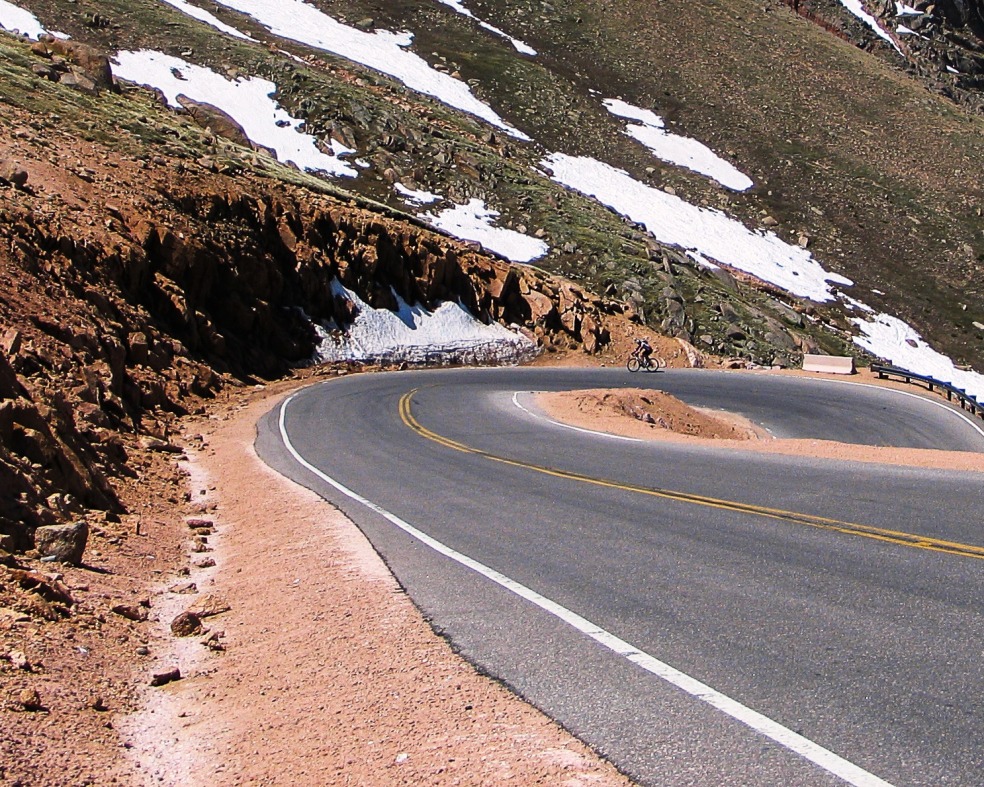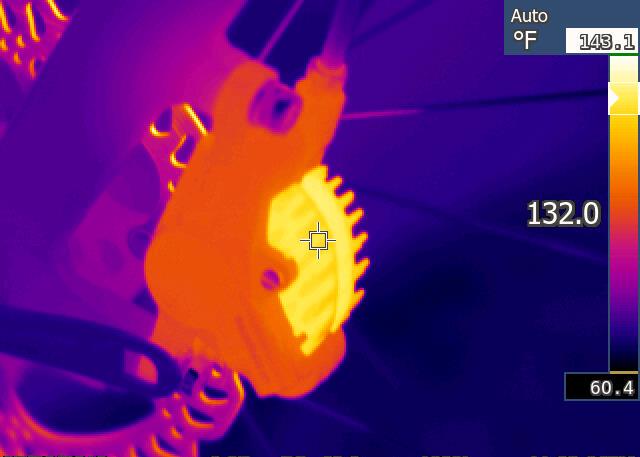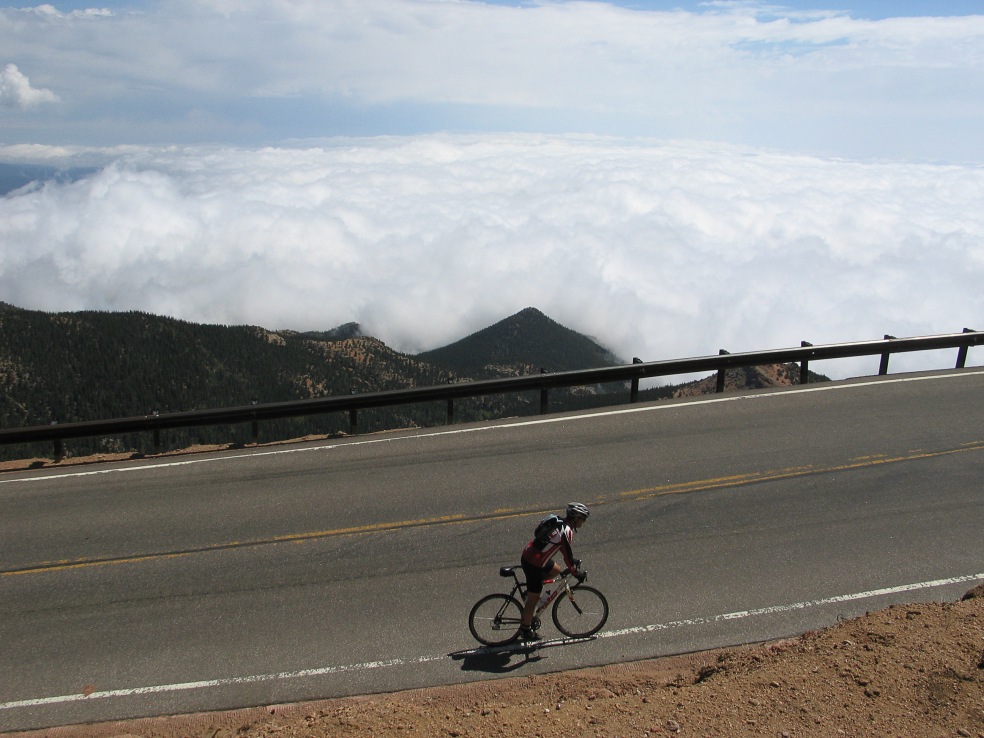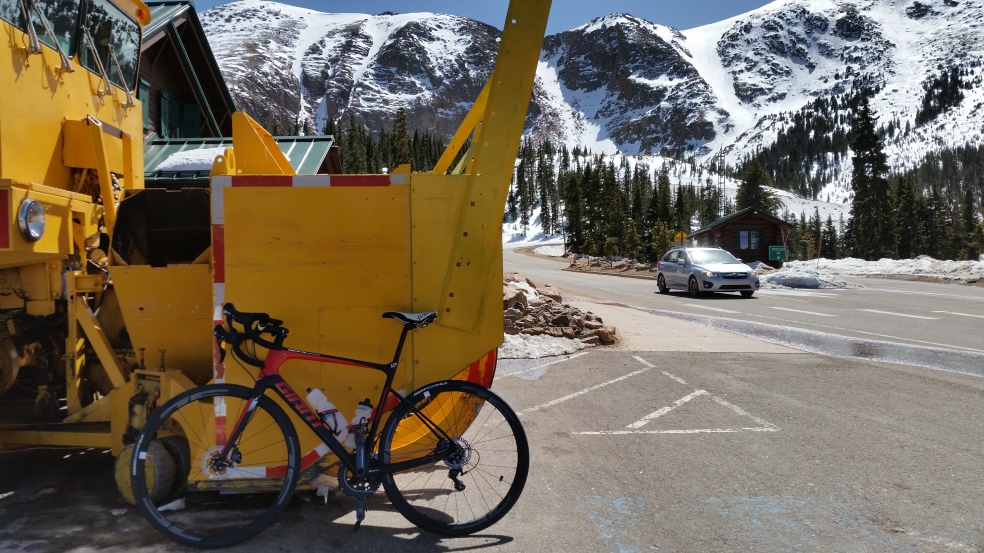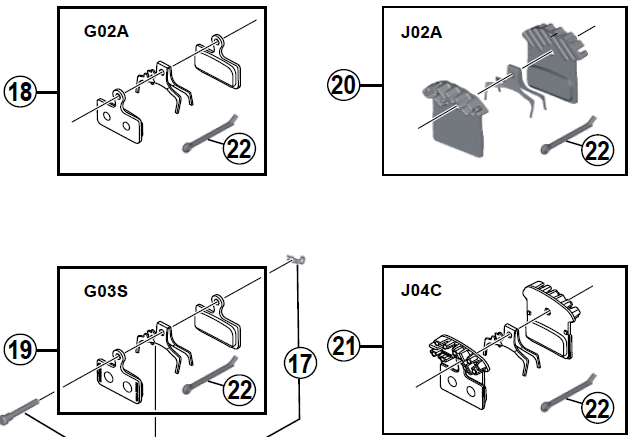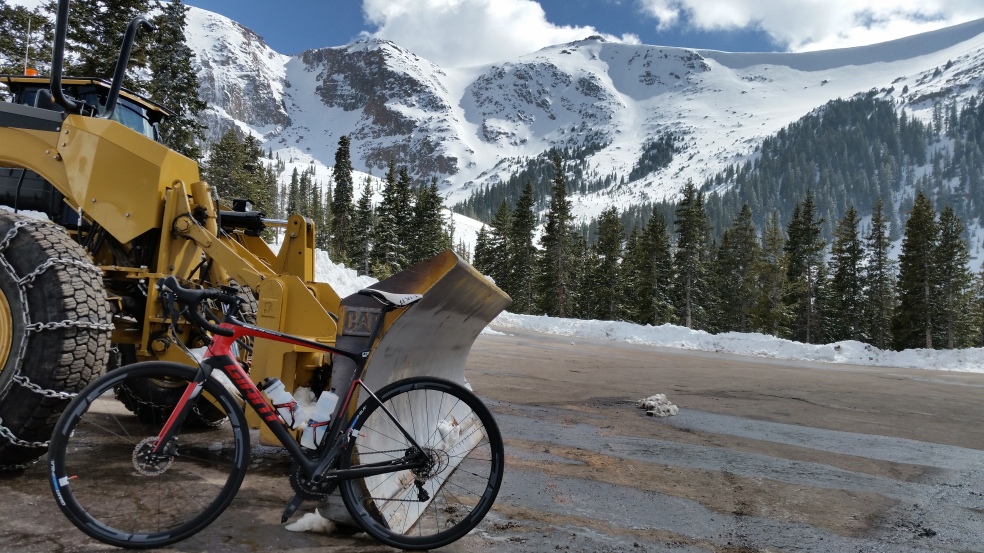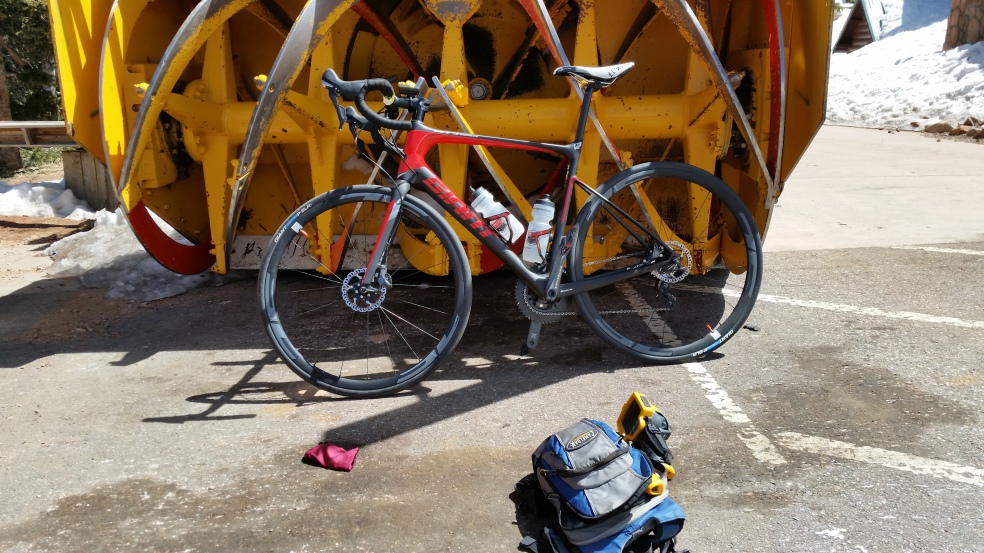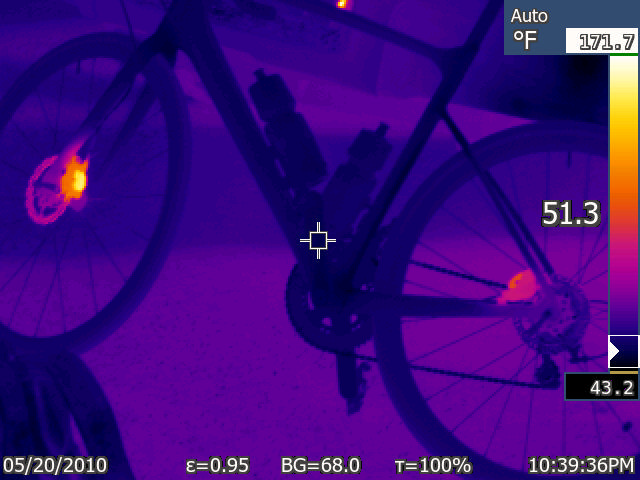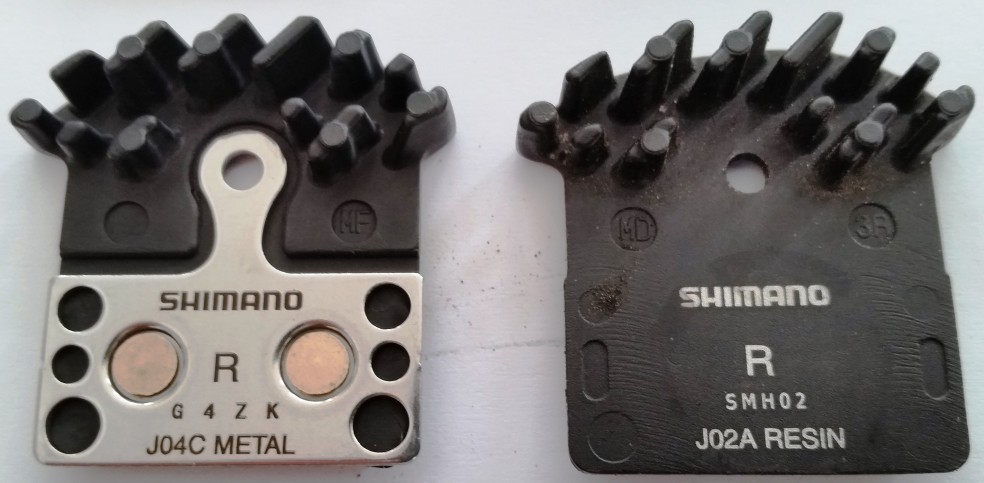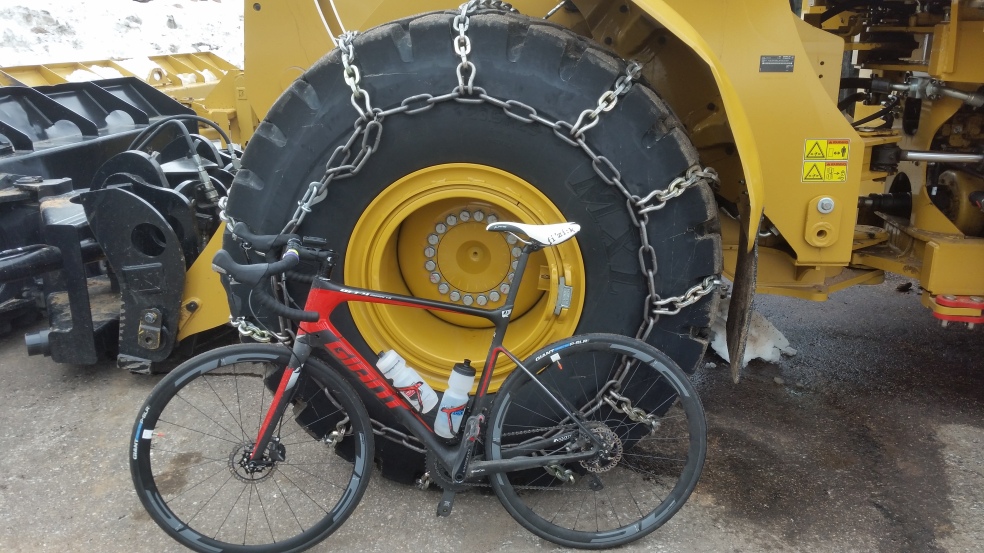I like riding in the mountains. I like riding safely in the mountains. But riding in the mountains occasionally entails getting caught in fast moving storms. If you don’t ride in the presence of a cloud your days in the mountains are limited and often disappointing that the storm never materialized. That said there is nothing scarier than descending with wet rims, braking full on and still accelerating under gravity. After watching road disc brakes materialize I purchased my dream bike for riding in the mountains, got disappointed, and decided the only way to remedy the problem was to research, experiment and gather data. This is journey to dial in road disc brakes. Hopefully it will help future road disc owners.
Prologue: An event that leads to another event or situation
Since opening to the biking public a couple years ago, the Pikes Peak Highway (PPH) represents an HC climb on my doorstep. Last year I leaned on it as a time efficient workout offering over 7000 feet of climbing in 19 miles. Every time I climb it’s a different ride depending on the weather, season, my training and mood. But every time I ride the Peak one thing is the same – that high alpine feeling you only get above tree line. Last summer I happened to be climbing the Peak the same day Susan MacEachern of Echo Hill Arts was out shooting and got these photos.
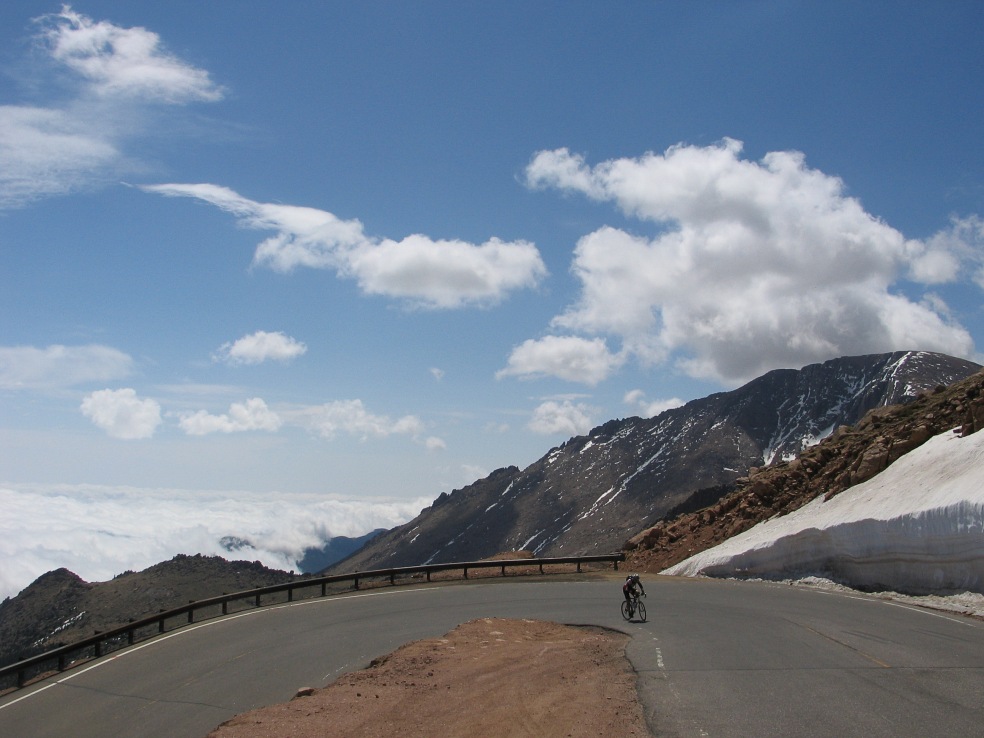 Last year after a couple white knuckle, wet road descents on my rim brake road bike I decided it was time to look at road disc bikes. I surveyed the field and landed on the Giant Defy Advanced Pro 1.
Last year after a couple white knuckle, wet road descents on my rim brake road bike I decided it was time to look at road disc bikes. I surveyed the field and landed on the Giant Defy Advanced Pro 1.
The Defy is an endurance bike meaning distinguishing features like a relaxed geometry, flexible seat stays designed to smooth the ride and capacity for wider tires (up to 28c). Many of the endurance bikes now include disc brakes, either hydraulic and cable. My Defy came equipped with the Shimano BR-RS785.
After the first few hundred miles of riding the rollers of Black Forest, I loved the Defy. While I primarily bought it for the braking performance, I quickly learned the compliance was perhaps its best feature. I am not sure how much is due to the 25C tires, the relaxed head tube angle or the absorbing design of the seat stays but riding it on well-known sections of road cracks left me pleasantly surprised that “compliance” was not just the latest marketing hype. It was noticeably more plush than my carbon, big tube era Douglas Matrix or aluminum Fuji Cross Pro.
After a few weeks and hundreds of miles breaking the Defy in, the PPH road opening, weather and Outlook schedule aligned. I was ready to finally bask in the perfectly controlled and confident descent thereby justifying the purchase. When the PPH opens early in the season, spring storms create ebbs and flows in how high up you can ride but in April that tends to be around Glen Cove (11,500ft) which is 4500ft of vertical gain from Cascade. Actually this is plenty in the early season as I am transitioning from Freestyle XC and Ski Mountaineering and building cycling base. So the prologue begins…
Maiden Voyage
According to Wikipedia The maiden voyage of a ship, aircraft or other craft is the first journey made by the craft after shakedown. I had ridden Pikes Peak 10 times last year and was excited to ride it for the first time in 2015 on the Defy. The ride up was great as the Shimano Ultegra 34/50 crank set coupled with the 11 speed cassette (11-28) offered a low enough gear (34-28) to manage the HC grade. 
I got to Glen Cove (11,450ft) and leaned the bike against the big snow cutter used to clear the road to put on a vest and and grab a picture.
As I rolled out of Glen Cove I was ready to enjoy the benefits of the research and purchase of the Defy. I descended braking smoothly but after dropping about 500ft over vertical the brakes began to howl and the bike shuttered front to back. I slid back in the saddle to help stabilize my position but after a couple hundred more feet pulled over to ensure the wheels were seated correctly. Within 3 switchbacks my vision of the perfect descent was crushed. I carefully managed down the next thousand feet uncomfortably wondering if the bike had ever been tested in such conditions. After a cooling off through the middle flats I got stuck behind a car for the last 1000 feet of descent. Rather than add acceleration and pass, I decided to use this to accelerate to the car then brake firmly to “bed in” the pads. As I got to my car at 7000 ft, I pondered if I had made the right bike decision or what the possible remediation could be. The Maiden Voyage was a failure that left me frustrated and even pining for my rim brakes.
Too Soon?
I researched road disc brake issues on the popular bike forums but found nothing on mountain descending with road bike discs. Mountain bike discs noise and vibration is covered with thousands of opinions and suggestions. Next I downloaded the manuals from the Shimano site and read through them.
![]()
I noticed that the BR-RS785 had 4 different pad options: resin or metal pads, with or without fins. I knew I had the fins but wasn’t sure if the pads that came stock in the Defy were fiber or metal. I called the Giant shop and talked to the mechanic and he wasn’t sure either. He said I should bring the bike up but between his uninspiring unfamiliarity with the brakes, a 2 hours round trip drive, and foreseeing a parking lot test ride leading to “no trouble found” I decided I needed to troubleshoot this myself. I’ve have had numerous disc brakes of my mountain bikes over the past 18 years so was familiar with pad removal and cleaning. I took out the pads and discovered they were the J02A Resin Pads w/Fin. Over the years I had gravitated towards metal pads on my XTR disc brakes so decided I should get some for the road bike. When I googled for the J04C Metal Pad with Fin, it was one of the rare times you couldn’t find something to buy off the web. A few e-tailers in Europe showed them but without stock and there were no US stores showing the item, let alone stock. It appeared the J04C pads were only available on eBay directly from Taiwan and no where else in the world. I wondered if I was the proverbial early adopter armed with “Beta” brake setup. In further research I discovered the J04C pad not only worked in my road bike but also was the new pad for my XTR brakes. I felt a little better that at least I had the same basic caliper and pad arrangement as the established mountain bike technology.
I reached out to Stephanie at the Giant shop explaining the scary undulations and excessive noise of the fiber pads on my first descent despite plenty of break in period and asked if she could help locate the metal pads. She called Shimano and was able to get a set of J04C pads shipped from Shimano so I could try them in the Defy. She apologized for my struggles and said she would comp them to me in exchange for further testing and feedback. Kudos to Stephanie @ Giant Denver.
Pikes Peak #2
I knew it would be another week before getting the metal pads so I decided to head up Pikes Peak again. I was hopeful that the bedding in process on the lower part of the mountain from the first trip and cleaning the pads and rotor would help. After braking through the first couple switchbacks the brakes began to howl again. The fore and aft shuttering was better but the overall experience was still not good.
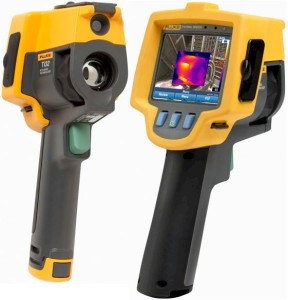
I felt a little better about the brake performance but decided I needed to gather some real data. The next day at work I located our Fluke Ti32 Thermal Imager and spent some time familiarizing myself with it. Best of all, it looked like it would fit inside my CamelBak Blowfish.
Pike Peak #3
Armed with the thermal imager, I headed up again to get some real data. I designed an experiment based on the previous 2 descents. I would climb to Glen Cove (zero braking going up), and begin a controlled descent. Since I was having issues within the first 500 vertical feet I decided to drop 1500 ft to a convenient pullout at the picnic area. I would not add any power during the descent and try to keep the bike under 30 MPH on the straight sections dropping to 15 MPH on the numerous switchbacks. At the picnic area I would park the bike in in 30 seconds, dismount, pull out the thermal imager and measure the temperature on the front and rear fins (heat sinks). The ambient temperature was about 52F. The heat sinks appeared to be working as I measured the front at 184F and the rear at 128F. While both front and rear were noisy and vibrating, the data showed me that I was favoring the front brake as it was 56F hotter. The next experiment I would try to even that out thermally.
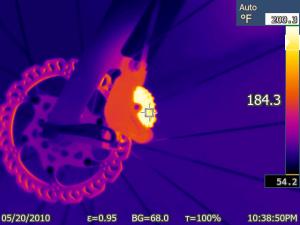
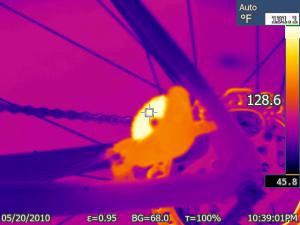
Pike Peak #4
Since the metal pads had not arrived yet, I decided to head up the Peak again to see if my experiment was repeatable and if I could even out my front and rear braking. A series of spring storms had kept the PPH closed at Glen Cove so there was no temptation to climb higher. The 13 mile, 4500 ft climb is a great 90 minute strength builder followed by a 25 minute descent- the perfect 2 hour early season workout.
In preparation for the Leadville Tail 100 MTB, I try to get at least 100 miles, 10,000 feet or 10 hours of riding each week starting in the spring once ski season winds down. This has served me well in the past being under 8 hours over six times (PR 7:44) and overall placing of 5th, 6th, 8th, 12th, 20th in the pre-Lance years before the race turned more professional. I have skipped the LT100 many years in favor of mountain running but 20 years since my first LT100 still managed an 8:26 last year in my mid 50’s.
As I descended from Glen Cove, I focused more on balanced front and rear braking hoping to even out the thermal load of the front and rear brakes. At the picnic area I was pleased that I got within 16F as the front was 150.6F and the rear was 166.2F. My back of the envelope conservation of energy calculations seemed to work out as the sum of previous ride of 312.9F (184.3 + 128.6) and this run was 316.8F. Amazingly the gap between the 2 experiments was less than 4 degrees farenhieit. I was feeling pretty good about the repeat-ability, but with the brakes still vibrating and scaring every chipmunk in a 2 mile radius, I was looking forward to the metal pads.
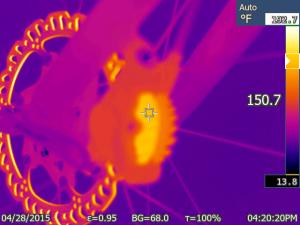
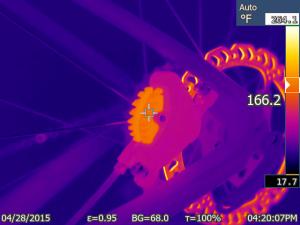
Shimano J04C Metal Pads
Finally, the J04C metal pads arrived. I was considering sanding the rotors with fine grit paper as some advised but looking at them under a magnifying glass the rotor surface area appeared good. I decided the fewer variables changed for the next test run the better. I simply changed out the stock fiber J02A pads with the metal J04C pads. Side by side, the metal pad is not only a more thermally conductive braking surface but also a much beefier pad including an additional silver metal plate that appears designed to conduct heat outward to the fins where the air flows.
 It was also good to see that Shimano made them backwards compatible with the F03C pads I had been running on my Santa Cruz Tallboy XTR brakes. I am not certain if the F03C is forwards compatible with the BR-RS785 Road Disc. Here is the compatability table from the back of the packaging.
It was also good to see that Shimano made them backwards compatible with the F03C pads I had been running on my Santa Cruz Tallboy XTR brakes. I am not certain if the F03C is forwards compatible with the BR-RS785 Road Disc. Here is the compatability table from the back of the packaging.
Pikes Peak #5 – Metal Pad Test
Finally the day arrived when work schedule, weather, road conditions and newly installed metal pads all aligned. As I climbed, I was cautiously optimistic since I had installed the pads the night before and did a driveway test before this 4500 ft vertical descent. I leaned the bike against the snow plow and glanced over at the thermometer on the ranger shack which read 50F, within a couple degrees of the previous four rides. I rolled out of Glen Cove with the goal of repeating the experiment the same as the previous two runs with the thermal imager. As I entered the 3rd switchback the brakes were still quiet and smooth. I continued to descend. expecting the next switchback to heat the brakes and start howling but all was good. The metal brakes have a less smooth sound than fiber but were performing well. I double checked on Strava later in the day to verify the same descent time of about 9 minutes. As I stopped at the picnic area, I quickly dismounted and pulled the imager out of the Camelbak just like before. I pointed it at the rear and was shocked as it was 261F, or about 100 degrees hotter than I measured on the fiber pads. The run was fairly balanced thermally as the front fins measured 250F. I couldn’t believe the difference not only in the temperature but more importantly in the actual performance. It seemed the metal pads were doing a better job of conducting the heat of friction away from the rotor and brake pad keeping them quiet and smooth. I expected some improvement but not 100F hotter on the fins.
After five weeks and 22,000 vertical feet of descending since the first disheartening ride of the Pike Peak Highway, I finally had it dialed in.
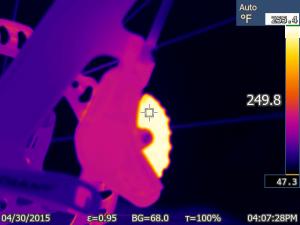
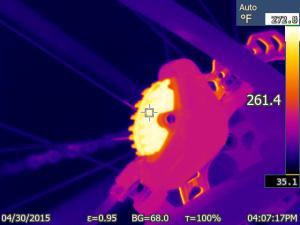
Summary… so far
I had another opportunity last week to climb to Glen Cove. But with dark clouds in every direction, I turned around at 3000 ft after seeing a lightning strike in the Devil’s Playground. Nevertheless, the descent was consistent with the previous ride as I dropped the vertical in one fell swoop hoping to reach the car before the snow/rain/hail reached me.
I did some rough math on the energy required to hold back my 200 lbs of ballast (rider,bike,gear) over 1500 of vertical across 9 minutes. Anyone with a thermodynamics background can correct me, and I am leaving out tire rolling resistance and wind, but given the rate at which the bike accelerates from Glen Cove under pure gravitational pull, I have to believe these are marginal. My calculus has Power = Work Done / Time to do the Work. Word Done is lbs * ft so 200 * 1500 = 300,000 ft-lbs divided by 540 seconds is 555 watts. I belive the metal pads do a better job of conducting those 550 watts from the braking surface to the air thus keeping the surface temperature lower.
No topic draws as much heat and light in the Mountain Bike forums as the subject disc brakes and how to remedy them so I gingerly offer my opinion to the other early adopters of disc road bikes:
1. Road bikes have far less mass and dampening ability than mountain bikes. A noisy or inconsistent MTB brake is annoying but greatly dampened by the mass of the frame, front and rear suspension, and the greater rotational mass of the MTB tires (about 700g vs 200gm). Road bike disc brakes need to be near perfect to make them enjoyable.
2. If you plan on riding in the mountains you might consider requesting Metal pads over fiber for the thermal performance and longevity. As of this writing (5/10/2015) the pads still don’t show up in the US so ask your LBS.
3. Don’t assume even tens of thousands of vertical in urban settings will translate to performance in a mountain descent.
We have had a very wet week with a couple feet of new snow on the peak in the past days. While thwarting many rides the moisture is welcomed compared to the alternatives of wildfire and water restrictions. While Glen Cove tends to remain accessible in the spring, the next section to consistently open will be the the next 1500 feet between Glen Cove and the Devil’s Playground as pictured here from last year as I round the switchback in the distance. I’ll post more on the road disc brake performance as I get further up the mountain. I am looking forward to the full 7000+ foot descent from the 14,110 foot summit of Pikes Peak to Cascade.
